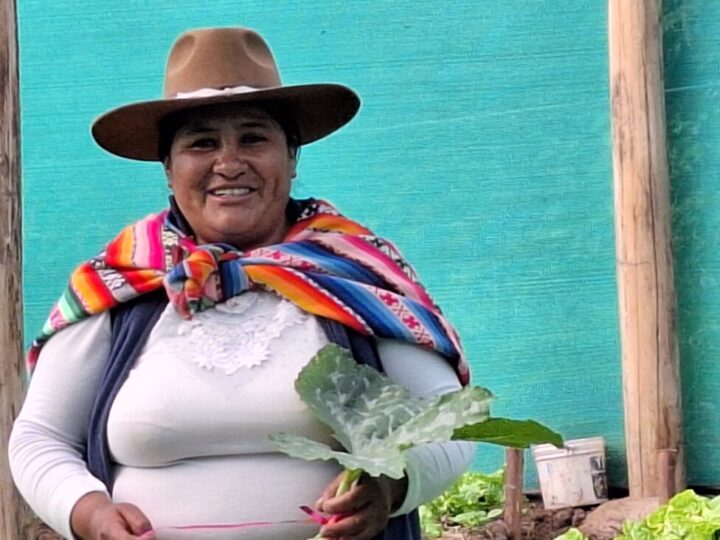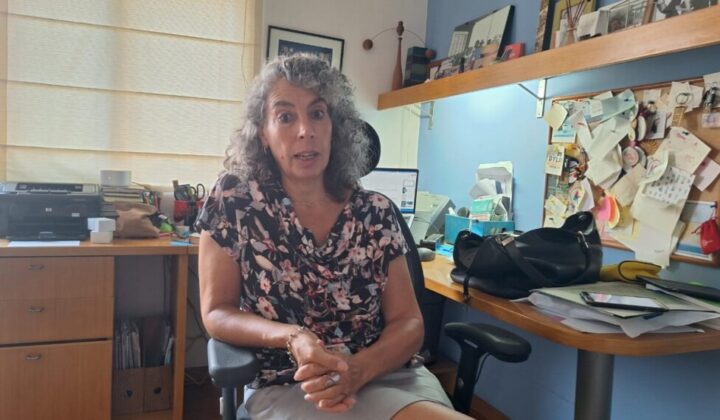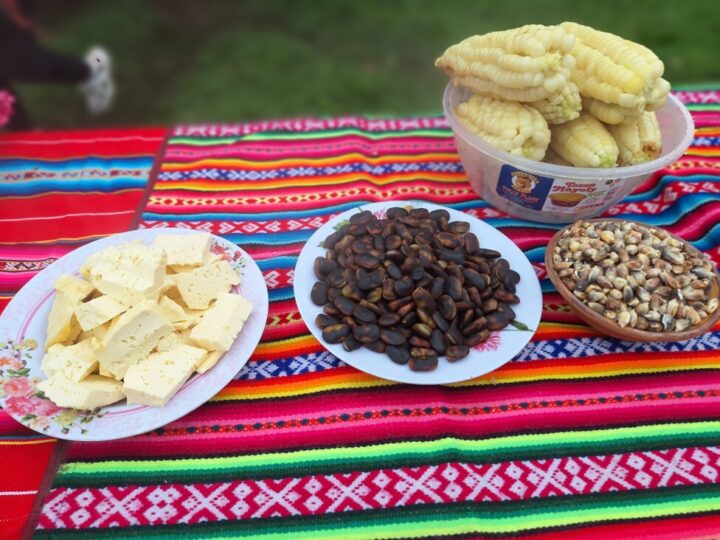ARTICLE AD
 A young Quechua mother, originally from Peru's southern Andes highlands, walks through the streets of Lima, carrying her young daughter in her lliclla (a colorful shawl made by native women in the Andes). A quarter of Peru's rural population under the age of five suffers from chronic malnutrition, clear evidence of inequality, which will have severe impacts on the rural child population. CREDIT: Wálter Hupiú / IPSby Mariela Jara (lima)Wednesday, March 27, 2024Inter Press Service
A young Quechua mother, originally from Peru's southern Andes highlands, walks through the streets of Lima, carrying her young daughter in her lliclla (a colorful shawl made by native women in the Andes). A quarter of Peru's rural population under the age of five suffers from chronic malnutrition, clear evidence of inequality, which will have severe impacts on the rural child population. CREDIT: Wálter Hupiú / IPSby Mariela Jara (lima)Wednesday, March 27, 2024Inter Press ServiceLIMA, Mar 27 (IPS) - Quechua farmer Felipa Noamesa, who lives in the southern Peruvian department of Cuzco, prepares a cream of fava bean soup for breakfast every morning with bread and vegetable soup with noodles. Her children are grown up, so her priority is that her five-year-old granddaughter does not suffer from anemia or malnutrition, two problems she frequently sees in her community.
"At my neighbors' homes there are little children who don't want to eat, who have swollen tummies, who have parasites, whose eyes look yellow and who fall asleep at school because they can't stay awake," the 44-year-old indigenous horticulturist told IPS during an interview at her plot of land in Paruro, the town where she lives with her husband, her daughter and her five-year-old granddaughter, Mayra, who she takes care of while her mother goes to school.
At their house they don't eat beef, pork or lamb, but they do eat guinea pigs (Cavia porcellus), an Andean rodent of recognized nutritional value, which she raises in a small shed next to her house, close to their organic garden.
"For lunch I make broth, stew or roast guinea pig and combine it with fresh corn, potatoes, vegetables from my garden and cheese," she said in her home in Paruro, the seat of the province of the same name, located more than 3,000 meters above sea level.
Peru, a country of 33 million people, faces a political and institutional crisis aggravated by the interim presidency of Dina Boluarte, who in December 2022 replaced Pedro Castillo, ousted and imprisoned for an attempt to seize control of all branches of power after less than 19 months in office.
The institutional crisis is compounded by an economic recession, the reduction of agricultural production due to climatic phenomena such as El Niño, and a poverty level that climbed to 30 percent in 2023, according to official provisional data.
Against this backdrop, the levels of anemia and malnutrition in children under five years of age are of concern.
According to official figures presented last year, chronic malnutrition affected 11.7 percent of the population, but with a greater impact in rural areas: 24 percent compared to seven percent in urban areas.
Other forms of malnutrition also present worrying indicators: 42 percent of the population aged six to 35 months has anemia, with a higher percentage in rural areas (51.5 percent) than in urban areas (39 percent). Meanwhile, nine percent of children under five years of age are overweight or obese.
In the Andes highlands department of Cuzco, with a population of 1.4 million divided among its 13 provinces, child malnutrition reaches 14 percent and anemia 51 percent. It is only surpassed by the central-western department of Huancavelica, which reports 29 percent child malnutrition. This situation reflects the harsh impact of inequality and poverty.
 Felipa Noamesa, a 44-year-old Quechua farmer, stands in her vegetable garden in Paruro, a village in the southern Peruvian department of Cuzco. Malnutrition is a common problem in her community and her concern is to feed her young granddaughter a nutritional diet so that she will grow up strong and healthy. CREDIT: Mariela Jara / IPS
Felipa Noamesa, a 44-year-old Quechua farmer, stands in her vegetable garden in Paruro, a village in the southern Peruvian department of Cuzco. Malnutrition is a common problem in her community and her concern is to feed her young granddaughter a nutritional diet so that she will grow up strong and healthy. CREDIT: Mariela Jara / IPSA price the whole country will pay
Carolina Trivelli, an economist and researcher at the Institute of Peruvian Studies, which has worked for more than 50 years in the country, said that as a result of the COVID-19 pandemic and the subsequent economic crisis, access to nutritious and healthy food for individuals and families has declined.
"Unfortunately chronic malnutrition stopped going down and has remained steady at around 11.7, 11.5, 12 percent over the last three to four years," the former minister of Development and Social Inclusion during the government of Ollanta Humala (2011-2016) told IPS in an interview at her home in Lima.
She said this has to do with the specific situation of families, the public apparatus and structural conditions such as high food inflation that affects the ability of families in a context of recession to afford food in sufficient quantity and quality to combat malnutrition. In addition, there is anemia, overweight and obesity.
Trivelli said these three elements make up a set of malnutrition problems that particularly affect the most vulnerable groups, including children from the poorest socioeconomic sectors.
 Economist and former Minister of Inclusion and Social Development of Peru, Carolina Trivelli, is interviewed in her home office in Lima. She warns about the cost that the country will pay over the next two generations due to the high level of chronic child malnutrition, a problem that she says should be a priority on the public agenda. CREDIT: Mariela Jara / IPS
Economist and former Minister of Inclusion and Social Development of Peru, Carolina Trivelli, is interviewed in her home office in Lima. She warns about the cost that the country will pay over the next two generations due to the high level of chronic child malnutrition, a problem that she says should be a priority on the public agenda. CREDIT: Mariela Jara / IPSWhen looking at the figures for consumption of food needed to address anemia and chronic child malnutrition, the difference between the consumption levels of the poorest 20 percent and the wealthiest 20 percent is enormous. So not only is there a problem of access to affordable food, but it is a major issue among the most vulnerable sectors.
"Peru is going to pay the cost of this, all Peruvians are going to pay it over the next two generations," she warned.
The expert in agricultural economics said that "Peru will have a couple of generations with much greater health problems, much lower productivity and many more restrictions to generate sustainable livelihoods in the broad sense."
 Ernesto Fisher is mayor of San Salvador, a town in the province of Calca in the southern Peruvian Andes highlands region of Cuzco, which has one of the highest levels of chronic child malnutrition in the country. The municipal government has put a priority on attention to the problem, but he said they need the support of the central government to ensure drinking water and sanitation for the entire population. CREDIT: District of San Salvador
Ernesto Fisher is mayor of San Salvador, a town in the province of Calca in the southern Peruvian Andes highlands region of Cuzco, which has one of the highest levels of chronic child malnutrition in the country. The municipal government has put a priority on attention to the problem, but he said they need the support of the central government to ensure drinking water and sanitation for the entire population. CREDIT: District of San SalvadorFocus on water and sanitation
Calca, another of Cuzco's provinces, contains some of the municipalities with the most worrying rates of malnutrition and anemia. For example, in the municipality of San Salvador, population around 6,000, child anemia stands at 26 percent.
This fact is related to the quality of their housing, most of which is in a precarious condition, while they have low levels of access to services, especially those who live in the countryside.
"From the mayor's office we are prioritizing food security projects for raising chickens and guinea pigs so that families can improve their nutritional intake, and we are also delivering iron syrup to health posts to be supplied to children and their mothers," the mayor, Ernesto Fisher, told IPS from San Salvador.
In a telephone interview, Fisher, in office since 2022, said that to eradicate the problem it is necessary to address water and sanitation deficiencies in his town. To this end, the municipal government is designing projects aimed at guaranteeing water resources for irrigation of family crops, drinking water and sewage services connected to the public network.
"Without sanitation it is impossible to talk about fighting anemia and malnutrition. We will not be able to complete it in this administration, but we will leave the projects on track so that eight years from now all of San Salvador will have running water and sanitation," he promised.
He called on the national authorities, especially President Boluarte, to prioritize projects that help close inequality gaps such as securing water for different uses. "The rest will come later," the mayor said, stressing that this should be the top priority.
 Boiled ears of fresh corn, pieces of cheese and beans, and roasted corn are common foods in the diet of rural Andean families in Peru. However, the decline in agricultural production due to droughts and other climatic events has reduced their access in quantity and quality. CREDIT: Mariela Jara / IPS
Boiled ears of fresh corn, pieces of cheese and beans, and roasted corn are common foods in the diet of rural Andean families in Peru. However, the decline in agricultural production due to droughts and other climatic events has reduced their access in quantity and quality. CREDIT: Mariela Jara / IPSIt's not just about budget funds
Peru's public policies reduced chronic child malnutrition between 2008 and 2016, as documented by the World Bank, which pointed to it as a successful experience.
However, the current situation shows that the problem is no longer seen as a priority. Trivelli said that it is not just a question of budget funds, but of combining multiple efforts simultaneously so that resources are spent effectively.
"We can give a family all the food and training they need, but if they don't have sewage, a safe water source, and proper solid waste management, the problems of chronic malnutrition and anemia are not going to be reduced. If those children go to a school that does not have toilets, we will continue to reproduce the cycle," she said.
Statistics show that it is the poorest people in rural areas and children who are directly affected by policies that do not place them at the center of their actions.
Trivelli argued that anemia and chronic malnutrition in children should be considered a priority problem of public interest addressed by a body at the highest political level, such as the Presidency of the Council of Ministers, in order to overcome the current scattered approach.
"We are not talking about a health issue only but about a crisis of food, development and poverty, and it needs to be part of the public agenda," she insisted.
© Inter Press Service (2024) — All Rights ReservedOriginal source: Inter Press Service

 9 months ago
56
9 months ago
56 